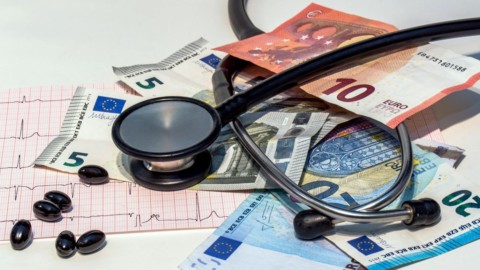La Italian public health expenditure amounts to 127,8 billion dollars, 7,3% of GDP. 21,4% (27,3 billion) of this figure originated from private structures, whose aggregate revenues reached 8,8 billion euros, up 15,2% on 2020 and 6,3% on the 2019. They are the masters Papinian (holding company of the San Donato hospital group and San Raffaele hospital in Milan) e Humanitas, but five out of 24 groups are in red. These are some of the data that emerge from the report on the major private healthcare operators in Italy of theMediobanca Studies Area which analyzes the financial data of the 24 main groups with individual turnover exceeding 100 million.
Healthcare expenditure: the international panorama and Italy's position
For OECD countries the average healthcare expenditure per capita it stood at around $4.350 in 2020 (9,8% of GDP). In comparison, Italy instead ranks below the average in per capita terms, with 3.700 dollars, while it is in line in relation to GDP (9,6%).
"Regarding public health expenditure alone, our country - with 7,3% of GDP in 2020 - is positioned in Europe behind Spain (7,8%), the United Kingdom (9,9%), France (10,3. 10,9%) and Germany (78,5%)”, reads the Mediobanca report, which explains how in absolute terms, Italian public health expenditure has increased at current prices from 2002 billion at the end of 127,8 to 2021 billion euro at the end of 6,4. The average annual growth was 2002% in the period 2006-0,9, 2012% between 2019 and 5,1, to expand further with the health crisis of the last two years (+XNUMX %).
Going forward with the data, in 2021 78,6% (100,5 billion) of the total value originated from public structures and 21,4% (27,3 billion) from those accredited. The expenditure disbursed by the latter shows growth (+3,2%) higher than that of public institutions (+2,4%) in the period 2002-2021, with the exception of the Covid emergency period, marked by numerous measures to strengthen the NHS.
During the pandemic, in particular, the expenditure of public structures rose by 6%, compared to +2,1% of those accredited. If we include services in solvency (increased from $31,5 billion in 2012 to $36,5 billion in 2021, +1,7% average annual growth) and the intermediation component (grown by 4,9% average annual 4,5 billion in 2021), total health care expenditure has totaled 168,8 billion in 2021 (+4,9% compared to 160,9 in 2020).
The impact of demographic dynamics on health expenditure
The demand for health services is also determined by demographic dynamics which highlight the constant aging of the population: in theOECD area, the incidence of the over 65s on the total increased from 8,9% in 1960 to 17,8% of 2021, with forecast to reach 26,7% in 2050. Italy, with its 23,5%, has a value well above the OECD average, behind only Japan (28,9%), expected to rise to 33,7% by 2050. At the same time, life expectancy has increased, which in the OECD area has gained over 10 years between 1970 and 2021, exceeding 83 years in eight countries. Also in this case Japan leads with 84,7 years, followed by Switzerland (84) and South Korea (83,5). Italy is in ninth place (82,9 years).
The healthcare offer in Italy
In Italy in 2021 they operated 28.980 in 2021, 57% of which are private and 43% public. Compared to 2010 there are 2.898 more facilities, 2.519 of which are private.
Il number of beds for ordinary hospitalization available to the NHS decreased by 8,6% on 2020, settling at 216,3 thousand units (in addition to 12.027 places in day hospital and 8.132 in day surgery), after the contraction of 12,6% between 2010 and 2019 (from 217 thousand to 190 thousand units).
The ranking of the major private healthcare operators in Italy
Excluding the consortium companies, there are 28 private players active in hospital and district care with individual turnover exceeding 100 million euros in 2021. Among these, 19 are specialized in hospital care, three in the management of nursing homes (KOS, Segesta and SO Holding), three in medical diagnostics (Cerba Healthcare Italia, Synlab and CDI) and three in functional rehabilitation (Don Gnocchi, Maugeri Clinical Scientific Institutes and San Raffaele in Rome).
Under the profile ofthe revenues, in first place in the standings we find Papinian (1 billion holding company of the San Donato Hospital Group and San Raffaele Hospital in Milan), in second and third place there are respectively Humanitas (1,084 billion) e GVM – Villa Maria Group (798 million). This is followed by the A. Gemelli University Hospital (787 million) and KOS (660 million.
With regard to the geographical diversification, KOS, SO Holding and Don Gnocchi are present in at least nine Italian regions, albeit with greater roots in the North. Among the hospitals, GVM and Gruppo Garofalo stand out with activities, respectively, in nine and eight regions. Papiniano and Humanitas are instead concentrated in Lombardy, with the first also active in Emilia-Romagna, where it develops 5,1% of revenues, and the second also present in Piedmont and Sicily where it generates approximately 21% of turnover.
“The division of activities between accreditation regime and solvency highlights a varied situation among operators”, underlines the report. In 2021, the minimum incidence of accreditation is marked by CDI whose diagnostic services are mostly intermediated by supplementary funds and insurance companies (41,8% of total revenues), by private individuals (22,4%) and by companies ( 11,4%). Among the other players, the expense of solvents recorded a greater incidence for KOS (36%) and IEO (35,4%), while the San Raffaele in Rome generates 94% of revenues in accreditation.
Turnover above pre-pandemic levels, profitability down
in 2021 the aggregate revenues of the 24 operators analyzed amounted to 8,8 billion euros, up by 15,2% on 2020 and 6,3% on 2019. These changes follow the annual decline of 7,8% in 2020, due to the suspension partial coverage of healthcare activities and the deferral of non-urgent scheduled hospitalizations. However, the overcoming of pre-crisis levels was not generalized: revenues rose by 6,7% for hospital operators and 44,1% for diagnostics, while the recovery did not materialize for rehabilitation players (- 0,3% on 2019) and for RSA managers (-0,2%).
Also recovering profitability, which however remains below pre-pandemic levels. "The measures to combat the epidemic have caused a significant increase in production costs, only partially covered by the refreshments provided for by specific emergency regulations"; explains the Mediobanca Research Area. L'aggregate ebit margin was thus negative in 2020 (-0,6%), but the intense vaccination campaign and the lower virulence of Covid-19 allowed the recovery of clinical activity and the improvement of the EBIT margin which rose to 3,7% in 2021, albeit still lower than the 6,0% of 2019.
At the individual company level, five groups close 2021 in the red, compared to ten in 2020. The aggregate ROE decreased from 7,2% in 2019 to 4,1% in 2021. The highest values are those of Humanitas (17,2%), Pro.Med (16,6 .12,6%) and the San Raffaele in Rome (XNUMX%).
Expectations for the sector
"The end of the state of health emergency in March 2022 and the simultaneous reduction of the limitations that characterized the two-year period 2020-2021 led to a progressive recovery of activities in the health sector and the simultaneous recovery of the waiting lists accumulated during the pandemic period" , highlights the report, according to which the first evidence for 2022 allows us to estimate ato growth in turnover at the aggregate level of the major private healthcare operators in the order of 4% on 2021, which however cannot be generalized to all sectors: this is the case, for example, of the sector of assisted healthcare residences for which a return to saturation of beds is estimated on pre-Covid levels not before 2025.





